Road Safety Laboratory

The Road Safety Laboratory (RS-lab), active since 2015, supports the activities of the CEAR-03A (Roads, Railways, Airports) scientific sector in the field of road safety analysis and design. The approach taken in the studies is multidisciplinary, thanks to active collaboration with laboratories and research centers in the field of cognitive and experimental psychology, and multiperspective, considering the needs, performance, and risks of any user (drivers as well as vulnerable users, such as cyclists and pedestrians). The laboratory is equipped to conduct experimental, observational, and naturalistic studies.
MAIN EQUIPMENT
Driving simulators
The RS-lab is equipped with two fixed-based driving simulators. The main driving simulator provided by AV Simulation offers a 130° horizontal and around 30° vertical field of view through three 32-inch Full HD screens, each with a resolution of 1920 × 1080 pixels. Supported by Nvidia GeForce RTX 4080 graphics card, the monitors refresh at a rate of up to 60 Hz and include rear and side-view mirrors. The simulator hardware includes a cockpit with a force-feedback steering wheel, manual gearbox, pedals, dashboard and an adjustable seat. In addition, integrated vibration pads simulate pavement roughness, wheel rolling, and shocks; and a 5.1 Dolby-surround sound system delivers realistic engine, road, wind, and other environmental sounds.
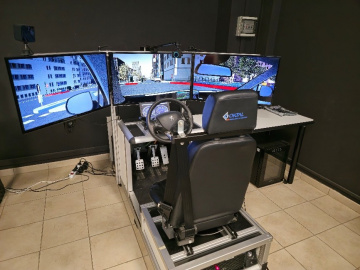 Main driving simulator
Main driving simulator
The road scenarios designed with SCANeR Studio® software can be reproduced in a virtual environment at 360° thanks to the integrated virtual reality system.
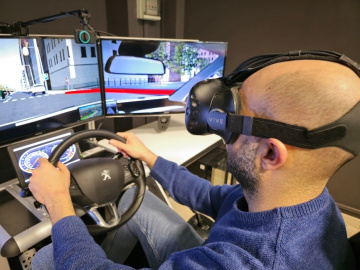 Virtual reality headset
Virtual reality headset
The second simulator is a compact and simplified version used mainly for scenario preparation and training. It consists of a 49-inch curved screen with a resolution of 3840 × 1080 and a cockpit with a Logitech G923 True Force racing wheel and pedals, a Logitech Driving Force gear lever, dashboard, and the seat.
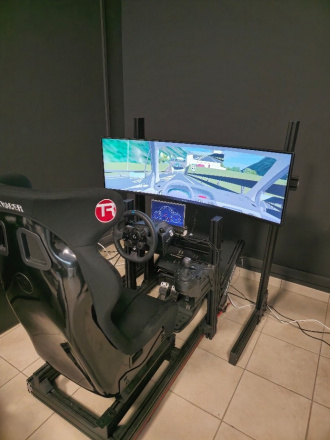 Second driving simulator
Second driving simulator
The simulation software used on both simulators is SCANeR Studio®. It provides tools to create highly flexible and realistic rural and urban road environments, including all necessary components such as markings, signs, traffic light systems, and roadside objects like buildings and vegetation. It also enables the simulation of various traffic scenarios involving surrounding vehicle traffic, cyclists, and pedestrians, and collecting a comprehensive set of data about driver behaviour. Thanks to the available AD/ADAS package licence, it is possible to implement Advanced Driving Assistance Systems (ADAS) and various levels of Automated Driving in simulations.
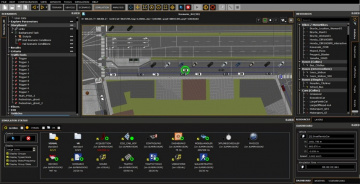 SCANeR Studio® software
SCANeR Studio® software
Biometric sensors
The RS-lab laboratory was recently equipped with a set of biometric sensors (PLUX Biosignals) for monitoring the biometric parameters of test drivers during experiments. Specifically, this set consists of piezo-electric respiration, electrodermal activity, electromyography, and electrocardiography sensors.
The piezo-electric respiration sensor detects thoracic or abdominal movements. Monitoring respiratory patterns is crucial in road safety research to assess factors such as driver alertness and stress levels. Respiration sensors provide valuable data on breathing dynamics, which can be analysed to understand physiological responses during driving.
 Piezo-electric respiration sensor
Piezo-electric respiration sensor
The electrodermal activity sensor measures changes in the skin's electrical conductance due to sweat gland activity, reflecting variations in sympathetic nervous system arousal. In road safety research, monitoring the electrodermal activity provides information about the drivers' emotional and cognitive states, such as stress or alertness levels.
The electromyography sensor detects the electrical activity produced by skeletal muscles, providing insights into muscle activation patterns and neuromuscular health. During driving simulation experiments, monitoring the electromyography helps assess drivers' muscle fatigue, ergonomics, and physical responses during vehicle operation.
The electrocardiography sensor records the electrical activity of the heart allowing for the study of physiological responses in various experimental conditions.
 Electrocardiography sensor configuration
Electrocardiography sensor configuration
Eye-tracker and hand-tracker
Vehicle guidance relies on visual information, so eye movement tracking is crucial to road safety research at the RS-lab. In addition, hand movements for vehicle control and interaction are closely analysed. Driving simulator experiments are often integrated with eye-tracking and hand-tracking devices to study the driver’s behaviour.
The RS-lab is equipped with a Pupil Labs Neon eye-tracking system that measures the gaze behaviour by capturing eye movements and fixation points. In road safety research, eye trackers are used to study how users perceive and interact with their environment. This data is valuable for understanding driver, pedestrian, and other road users’ behaviour, improving traffic safety measures, and optimizing user-interface designs.
![]() Eye-tracking and heatmap of driver’s gaze
Eye-tracking and heatmap of driver’s gaze
The RS-lab uses the Leap Motion Controller 2 by Ultraleap, an advanced optical hand-tracking device with a 160° × 160° field of view and a 10-110 cm tracking range. It can track 27 hand elements, including bones and joints, even during object interactions. This technology helps to analyse driver hand positions and gestures in simulated driving, aiding in the design of safer and more intuitive vehicle control systems.
Driving anti-distraction devices
Driver distraction has become one of the main issues in road safety, contributing to a significant number of road crashes worldwide. Sources of distraction include mobile phones, in-vehicle systems, and even driver fatigue. To mitigate these risks, anti-distraction devices have been developed aiming to monitor driver behaviour and provide alerts to maintain focus on the road.
An auditory Driver Distraction Warning device is integrated into the main driving simulator, to monitor driver attention and provide real-time alerts, just as it would in real-world driving conditions. It is used to study driver behaviour, evaluate the effectiveness of anti-distraction technologies, and assess the impact of distractions on driving performance in different road environments.
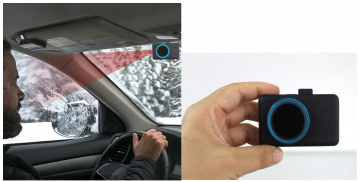 Driver Distraction Warning device
Driver Distraction Warning device
LiDAR sensors
LiDAR (Light Detection and Ranging) sensors emit pulse laser lights that are reflected from background objects and users moving in the road environment. In road safety analysis, LiDARs are used to collect the position of fixed and moving entities in the road environments, capturing the movements of vehicles, pedestrians, and cyclists with high precision. Such information is then analysed to extract traffic conflict indicators (i.e., surrogate measures of safety) for safety analysis.
The RS-lab is equipped with two Quanergy M8-Prime Ultra LiDAR sensors capable of detecting trajectories up to 100 meters away. Each LiDAR sensor is mounted on a tripod, allowing for installation at heights of up to 4 meters. In addition, each unit comes with a laptop for configuration and data collection (Quanergy Q-View and Qortex-client software), as well as a portable power station that allows for in-field testing without the need for an external power source.
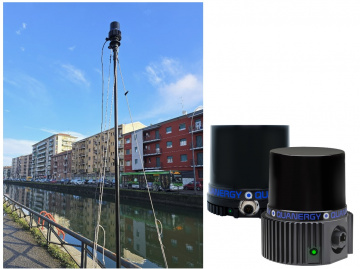 Quanergy M8-Prime Ultra LiDAR sensors
Quanergy M8-Prime Ultra LiDAR sensors
Albedometer
Albedo is defined as the fraction of solar radiation reflected by a surface relative to the incident radiation. Measuring the albedo of pavements is necessary to evaluate their thermal properties and to design cooler and more sustainable urban environments. In fact, pavements with low albedo absorb more solar radiation, resulting in higher surface temperatures. This heat accumulation can contribute negatively to the urban heat island effect.
Albedometers consist of two pyranometers mounted back-to-back that measure solar radiation in two directions. The up-facing pyranometer measures global solar radiation, while the down-facing pyranometer measures reflected solar radiation. Albedo is the ratio of incident global radiation to reflected global radiation.
The RS-lab has a Delta Ohm LP PYRA 06 albedometer. The electrical signals from the two pyranometers are sent to a data logger for data collection.
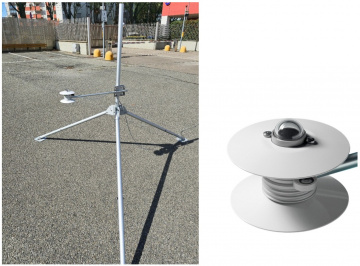 Delta Ohm LP PYRA 06 albedometer
Delta Ohm LP PYRA 06 albedometer
LABORATORY
DIATI door 2, ground floor, 5607
| Type | Teaching and research laboratory |
|---|---|
| roadsafety.lab@polito.it | |
| Staff |
